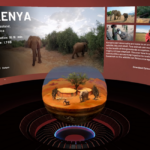Virtual reality (VR) technology is the use of a headset to replace the real world with a digitally rendered environment. The user takes part in a simulated experience and can interact with their virtual surroundings and virtual characters. Although VR technology has been available since the 1970s, recent advances in technology have vastly increased its usefulness and application.

The health-care sector is beginning to recognize the potential of VR for a range of medical uses, with some expecting the sector to become the most prevalent application of VR outside of gaming. Recent trials have shown it to be an effective tool for the management of acute and chronic pain, as it provides a distraction from stimuli and decreases an individual’s perception of pain.[1] VR has also been used to explore the response of doctors to important ethical issues such as the overprescription of antibiotics.[2] The technology is showing some promising signs as a rehabilitation tool too, for example, for poststroke patients [3] and children with cerebral palsy.[4]
VR is also proving to be an excellent way of training health-care professionals. It can be a challenge to ensure that all medics are trained to the same standard, especially as access to the latest equipment is often limited. VR technology can be used to train medical professionals on new techniques and technologies in a cost-effective way, ensuring consistency and removing the need to take important equipment out of service.
As with most new technologies, there has been some initial scepticism from practitioners to the introduction of VR, but this is diminishing as more use cases are created and results documented.
Immerse has been working with GE Healthcare to create a VR training tool for completing computed tomography coronary angiography (CTCA) scans. The updated National Institute for Health and Care Excellence (NICE) clinical guidelines suggest CTCA as the first line of investigation for patients with chest pain in both typical and atypical circumstances.[5] Highly sensitive, it can diagnose coronary artery disease and help detect those at risk of having a cardiac problem in the future. It is an excellent tool for ruling out coronary disease as the reason for chest pain.
CTCA is still quite a new technique, and it can only be performed using relatively modern CT scanners – there are currently only 228 cardiac capable scanners in the UK. This means that there are very few radiologists trained in CTCA: as of 2014, the UK had 48 CTCA-trained radiologists per million population, compared with 92/million in Germany, 112/million in Spain, and 130/million in France.[6]
The Royal College of Radiologists and the British Society of Cardiovascular Imaging estimate that in 2017, there was a shortfall of 43% in the number of CTCA scans that should have been performed in the UK if the NICE guidelines had been followed.[7]
In the UK, there is no formal, consistent training pathway for CTCA scanning. Current training is usually limited to 3–5 days of offsite training, generally consisting of lectures, case study reviews, and literature.
GE Healthcare wanted to address these restrictions by creating a VR environment that simulated the hands-on experience of completing CTCA scans. Their aim was to make a training tool that could be accessed 24/7, reducing the need for onsite training and therefore lowering training costs and minimizing health risks to patients. Ultimately, this should mean that more radiographers are CTCA trained, leading to better assessment of patients and better outcomes.
Working closely with GE Healthcare and subject-matter experts (cardiology and CTCA-trained radiographers), Immerse developed a detailed VR environment with various patient case studies to play-through, each with differing modes (modules) to allow the user to be either guided or unguided.
The patient setup involves multiple interactions, from calling a doctor, talking to the patient, attaching leads to them, controlling their heart rate, and then positioning them in the scanner. There is a fully simulated software interaction flow for acquiring the final scan images, using a design that is generic enough to be applied to any scanner. For future versions, a third “assessment” mode is planned, for users to run through the simulation completely unguided, with data from the session fed into Immerse’s reporting platform for further analysis and playback. This allows the simulation to be used as part of a formal assessment program.

Radiographers who have tested the CTCA program so far have given positive feedback, welcoming the ease-of-use and the detail of the simulation. In situ beta-tests have taken place at several UK hospitals, and we are currently working with GE Healthcare to roll out the program globally.
VR is so effective in a health-care training context because it is completely engaging and immersive, accurately replicating the experience of dealing with a variety of patients and equipment. Gamification can also be applied to add competitive elements, encouraging staff to revisit modules to improve their skills and scores. While the effectiveness of training has historically been hard to measure, VR changes this: simulations such as the CTCA program capture huge amounts of data, which Immerse technology presents back to employers, enabling the tracking of progress, outcomes, and offering insights for improvements and future training. Data can be collected on an individual as well as an aggregated level, so that simulations can then be personalized to suit individual users. Insights will only improve as more advanced data capture techniques are integrated, including eye-tracking, biometric technology, and even brainwave monitoring.
VR has a critical role to play in the future of health-care training. As our work with GE Healthcare shows, using a realistic VR training simulation brings financial and logistical benefits. It can help overcome barriers to training including access to equipment, time and location limitations, and a lack of relevant patient types on whom to practice. However, the key to any successful adoption is getting the technology into the hands of the key influencers and turning them into advocates. In the case of health-care training, this means working closely with medical professionals to develop VR solutions that are truly useful, relevant, and applicable.
References
- Pourmand A, Davis S, Marchak A, Whiteside T, Sikka N. Virtual reality as a clinical tool for pain management. Curr Pain Headache Rep 2018;22:53.
- Pan X, Slater M, Beacco A, Navarro X, Bellido Rivas AI, Swapp D, et al. The responses of medical general practitioners to unreasonable patient demand for antibiotics – A study of medical ethics using immersive virtual reality. PLoS One 2016;11:e0146837.
- De Luca R, Lo Buono V, Leo A, Russo M, Aragona B, Leonardi S, et al. Use of virtual reality in improving poststroke neglect: Promising neuropsychological and neurophysiological findings from a case study. Appl Neuropsychol Adult 2019;26:96-100.
- Pourazar M, Mirakhori F, Hemayattalab R, Bagherzadeh F. Use of virtual reality intervention to improve reaction time in children with cerebral palsy: A randomized controlled trial. Dev Neurorehabil 2018;21:515-20.
- “Chest Pain of Recent Onset: Assessmenzt and Diagnosis” Available from: https://www.nice.org.uk/guidance/cg95. [Last accessed on 2019 July 01].
- “How the Next Government can Improve Diagnosis and Outcomes for Patients: Four Proposals from the Royal College of Radiologists.” Available from: https://www.rcr.ac.uk/sites/default/files/RCR(15) 2_CR_govtbrief.pdf. [Last accessed on 2019 July 01].
- Wise J. CT scan shortage endangers angina patients, say radiologists. BMJ 2018;363:k4719.
Quelle:
The Use of Virtual Reality Environments for Medical Training


